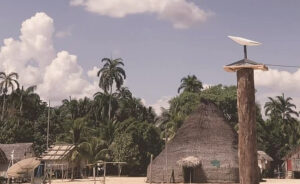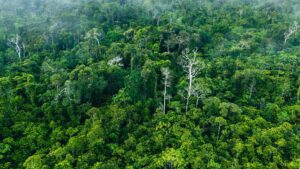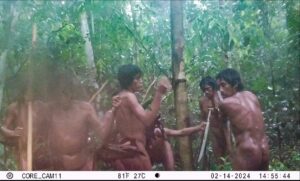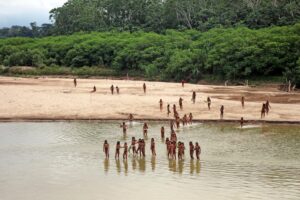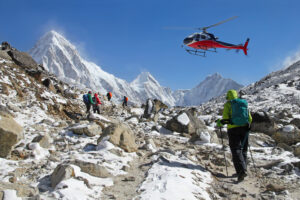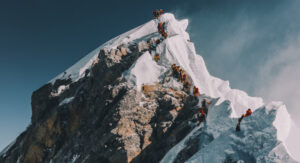Pete Casey is following the mighty Amazon river in the most ambitious and intimate way possible: walking, sometimes swimming every inch of the Amazon from sea to source, and in the process interacting with its people and its wildlife face to face at ground level.
“Water or Gold”
I could clearly see the sand banks of Jurura that the seasonal low water levels had exposed. The calm dark waters of the Nhamundá river reflected the blisteringly hot sun and deep blue cloudless sky, while in the foreground sprawled the lush greens of the jungle. Several times I had walked to this point contemplating and planning the swim across this landmark of my adventure whilst waiting for my current walking companion Valdo to return. To cross would take me from the border of Pará into Amazonas and into a different time zone.
A few local children were flying homemade kites made from fishing line, sticks and plastic carrier bags. I asked them if it was safe to swim. They laughed and one drew a line in the sand about six meters long saying “Jacaré (Caiman) this big here.” Nonetheless, based on local advice (and allowing for the exaggeration factor) and my own experience so far, I had calculated that it was safe enough to swim across. I have, after all, swum every body of water, every river and tributary I have so far come across. I thought back to the early stages and the Marajó’s jungles and rivers, which had been incredibly difficult to cross, especially at the high annual flood season. In hindsight, if I had known what I was letting myself in for, I probably would have taken the much much easier and safer but less interesting route through all the connected roads on the other side of Baia de Marajó via Belem. It would also have saved me at least two months of my time. Then again, I felt that the most easterly point of Marajó was the truest location of the mouth of the Amazon as it pours out into the Atlantic ocean. Anyway, I wasn’t about to pass on this latest swim because of local kids’ advice.
I was eager to swim across to Jurura, and waiting for my walking companion Valdo, who had still had not returned after going home to vote in the elections, had been frustrating. He also had the other backpack and gear. I was relieved when he finally returned, and we got going straight away the next morning.
I swam the 3K across to Jurura then started the traverse to Urucará.
Again I changed the route after a few very tough days walking near and beneath the power lines. It was dangerously steep closed forest, unbearably hot with thousands of bloodthirsty mosquitos, so that we only made 7K in two long uncomfortable days.
I decided to risk a much quicker and more scenic route along the dried-out banks of the Amazon. Amazon river levels change dramatically from high river rainy season to low water dry season, and with current low water levels the big lakes (lagos) had been separated from the main river apart from a few small rivers, so the route was walkable – just.
As we walked along a section of rock freshly exposed by the receding waters of the Amazon, I noticed Valdo picking up rocks and jokingly saying “ouro” (gold).
I was feeling philosophical…
“What do you think is more valuable, Valdo – fresh water or Gold?” I asked.
“Gold, of course,” he shot back.
“Hmm. It would be great to find a nugget of gold here, but you are really lucky where you live – you have an abundant supply of fresh water in the Amazon basin, while in some other parts of the world many people don’t have enough and sometimes people die because of it.”
Valdo grunted.
I said “If you were in the middle of a hot, dry plain far from any rivers and you were given the choice between finding fresh water or gold what would you take?”
No reply.
“You can live a whole life without gold, but you can’t live more than a few days without fresh water, that’s why i think water is worth more than gold. What do you reckon?”
Valdo remained silent, but at least I had convinced myself.
On this last leg I’ve seen much more diverse wildlife than before, with too many insects, birds and animals to list, and most of them too fast-moving to grab a camera and capture images. I imagine it would be an ornithologist’s dream to walk through the wetlands here, where there is an incredible array of brightly coloured and different sized birds. One large tree alone had at least 50-80 Hoatzin sitting in its branches on the riverbank.
I am now in Itapiranga, ready to head on to the big bustling hot tropical jungle city of Manaus, international gateway to the Amazon rainforest and sited at the mouth of one of the bigger tributaries – the Rio Negro,. Where the Negro meets the Amazon is the famous “meeting of the waters”, and another expedition landmark for me.
Ahead of Manaus the roads are few and far between, and looking at the map I see just a green ocean of rainforest to cross.
By Pete Casey, Oct. 25, 2016
To see original blog post please go to:
https://www.ascentoftheamazon.com/2016/10/river-of-life/
Posted by Piotr Chmielinski – for last few months I was observing a progress of this interesting, first time attempted, ascent of the Amazon River from the Atlantic to the source area, by walking and swimming if needed. Not an easy task. So far Pete made from Atlantic to Manaus – difficult part – about 1/4 of the distance.
If you remember – previously Ed Stafford did a descent of the Amazon (Impressive!!! – check this book)
Ascending – many times against the water currents – is more difficult in comparison to descending. Best to Pete, be safe!!

